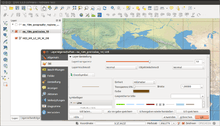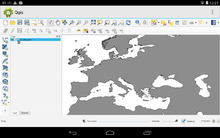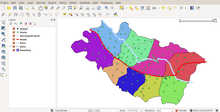QGIS
QGIS (until 2013 known as Quantum GIS[2]) is a free and open-source cross-platform desktop geographic information system (GIS) application that supports viewing, editing, and analysis of geospatial data.[3]
 QGIS 2.2 showing the redesigned menus. | |
| Developer(s) | QGIS Development Team |
|---|---|
| Initial release | July 2002 |
| Stable release | 3.14.1 "Pi" (July 19, 2020[1]) [±] |
| Preview release | None [±] |
| Repository | |
| Written in | C++, Python, Qt |
| Platform | Windows, Linux, Mac OS X, Android(beta) |
| Available in | Multilingual |
| Type | Geographic information system |
| License | GNU GPLv2 |
| Website | qgis |
Functionality
QGIS functions as geographic information system (GIS) software, allowing users to analyze and edit spatial information, in addition to composing and exporting graphical maps.[3] QGIS supports both raster and vector layers; vector data is stored as either point, line, or polygon features. Multiple formats of raster images are supported, and the software can georeference images.
QGIS supports shapefiles, coverages, personal geodatabases, dxf, MapInfo, PostGIS, and other formats.[4] Web services, including Web Map Service and Web Feature Service, are also supported to allow use of data from external sources.[5]
QGIS integrates with other open-source GIS packages, including PostGIS, GRASS GIS, and MapServer.[5] Plugins written in Python or C++ extend QGIS's capabilities. Plugins can geocode using the Google Geocoding API, perform geoprocessing functions similar to those of the standard tools found in ArcGIS, and interface with PostgreSQL/PostGIS, SpatiaLite and MySQL databases.
Development
Gary Sherman began development of Quantum GIS in early 2002, and it became an incubator project of the Open Source Geospatial Foundation in 2007.[6] Version 1.0 was released in January 2009.[7]
In 2013, along with release of version 2.0 the name was officially changed from Quantum GIS to QGIS to avoid confusion as both names had been used in parallel.[2]
Written in C++, QGIS makes extensive use of the Qt library.[5] In addition to Qt, required dependencies of QGIS include GEOS and SQLite. GDAL, GRASS GIS, PostGIS, and PostgreSQL are also recommended, as they provide access to additional data formats.[8]

As of 2017, QGIS is available for multiple operating systems including Mac OS X, Linux, Unix, and Microsoft Windows.[9] A mobile version of QGIS was under development for Android as of 2014.[10]
QGIS can also be used as a graphical user interface to GRASS. QGIS has a small install footprint on the host file system compared to commercial GISs and generally requires less RAM and processing power; hence it can be used on older hardware or running simultaneously with other applications where CPU power may be limited.
QGIS is maintained by volunteer developers who regularly release updates and bug fixes. As of 2012, developers have translated QGIS into 48 languages and the application is used internationally in academic and professional environments. Several companies offer support and feature development services.[11]
Function
Layers
QGIS can display multiple layers containing different sources or depictions of sources.
Preparing maps

In order to prepare printed map with QGIS, Print Layout is used. It can be used for adding multiple map views, labels, legends, etc.
Licensing
As a free software application under GNU GPLv2, QGIS can be freely modified to perform different or more specialized tasks. Two examples are the QGIS Browser and QGIS Server applications, which use the same code for data access and rendering, but present different front-end interfaces.
Adoption
Many public and private organizations have adopted QGIS, including:
- US National Security Agency [12]
- Austrian state of Vorarlberg
- Swiss cantons of Glarus and Solothurn [13]
- New Zealand's Land Information public service department [14]
Training

Many QGIS training opportunities are available including dedicated YouTube Channels,[15][16] online tutorials,[17] and textbooks [18]
References
- "Releases - qgis/QGIS". Retrieved 19 July 2020 – via GitHub.
- "Changelog for QGIS 2.0 - Quantum GIS is now known only as 'QGIS'". QGIS. Retrieved 1 January 2020.
- "QGIS Official Website". QGIS. Retrieved 16 October 2013.
- Gray, James (2008-03-26). "Getting Started With Quantum GIS". Linux Journal.
- Cavallini, Paolo (August 2007). "Free GIS desktop and analyses: QuantumGIS, the easy way". The Global Geospatial Magazine.
- OSGeo (February 2008). "OSGeo Annual Report 2007".
- Tim Sutton (January 23, 2009). "Announcing the release of QGIS 1.0 'Kore'". Retrieved 2009-01-26.
- "Project details for Quantum GIS - Quantum GIS 0.9.0". Freshmeat. Retrieved 2008-12-31.
- "Download QGIS". QGIS.org. Retrieved March 31, 2017.
- "QGIS for Android". Archived from the original on 21 October 2011. Retrieved 25 September 2014.
- "Commercial support". www.qgis.org. Retrieved 2017-05-01.
- "QGIS related repositories on GitHub - NSA". GitHub. Retrieved 31 March 2020.
- "QuantumGIS (QGIS) – freie GIS-Software". Land Vorarlberg. Retrieved 12 October 2013.
- "QGIS related repositories on GitHub - LINZ". GitHub. Retrieved 31 March 2020.
- https://www.youtube.com/playlist?list=PLEG4qT_nMsCVEb0D0V8KFYJFC2UvXiipD
- https://www.youtube.com/watch?v=lg9ceXoCUFE
- https://www.qgistutorials.com/en/
- https://www.packtpub.com/big-data-and-business-intelligence/mastering-qgis-second-edition
External links
| Wikimedia Commons has media related to QGIS. |